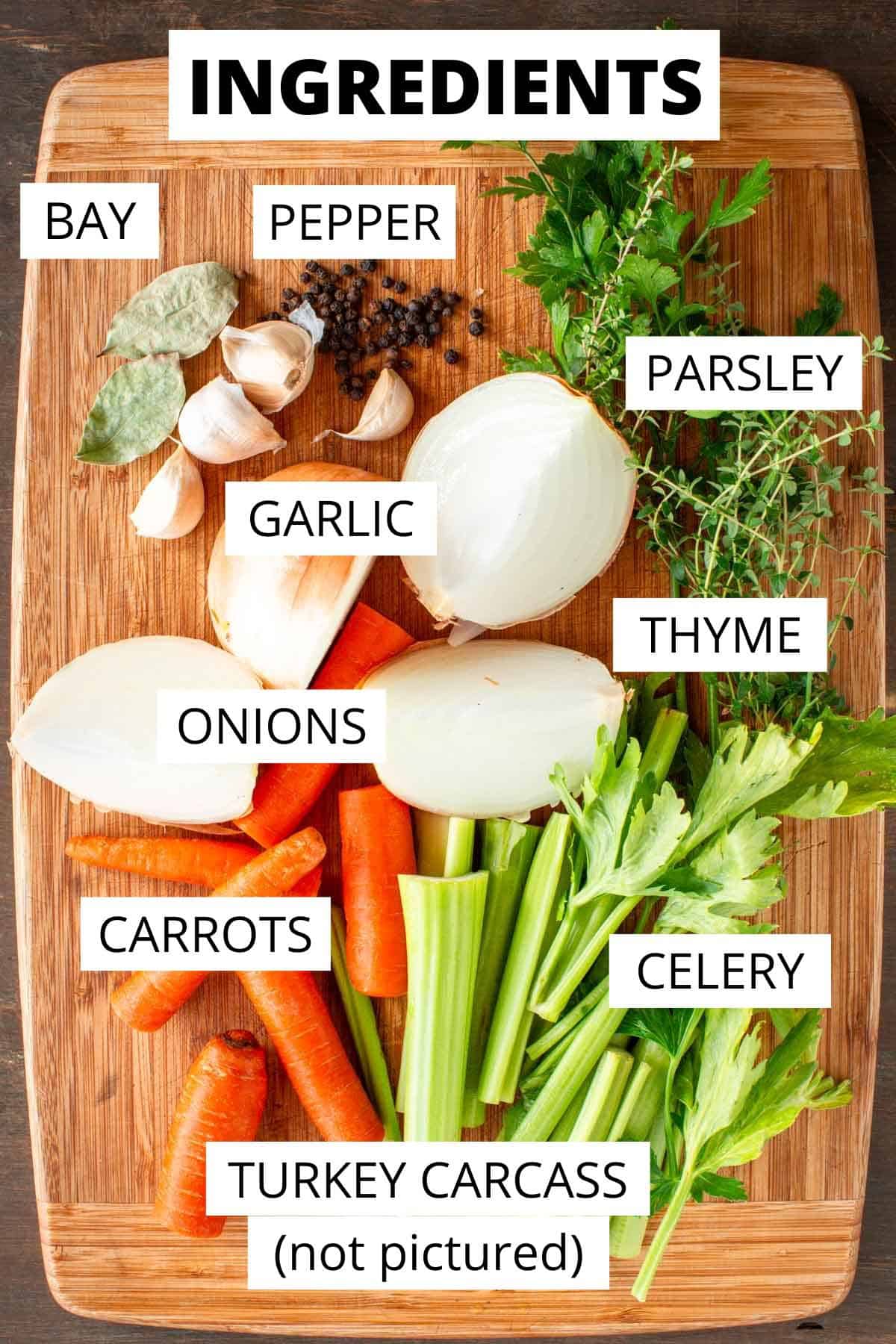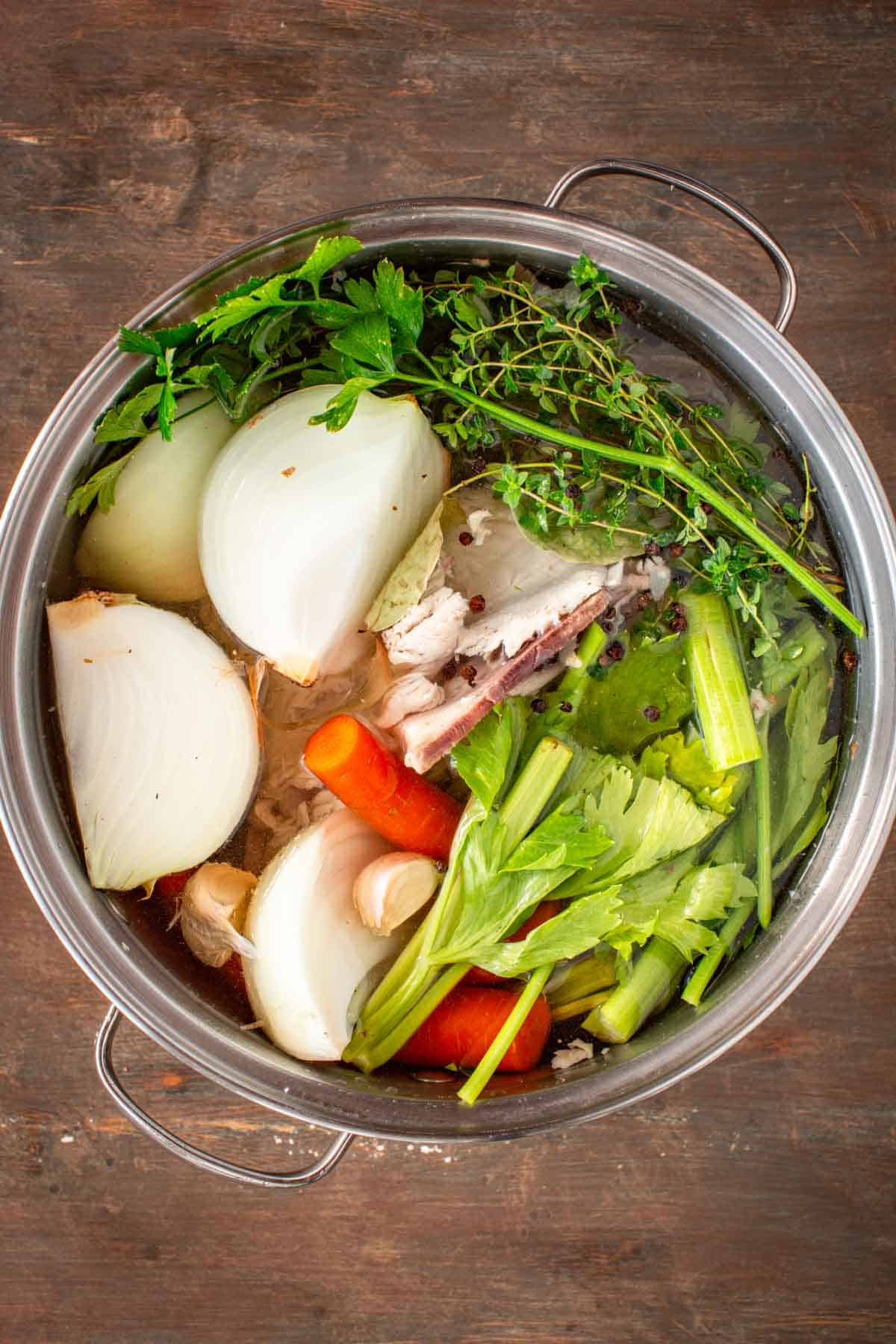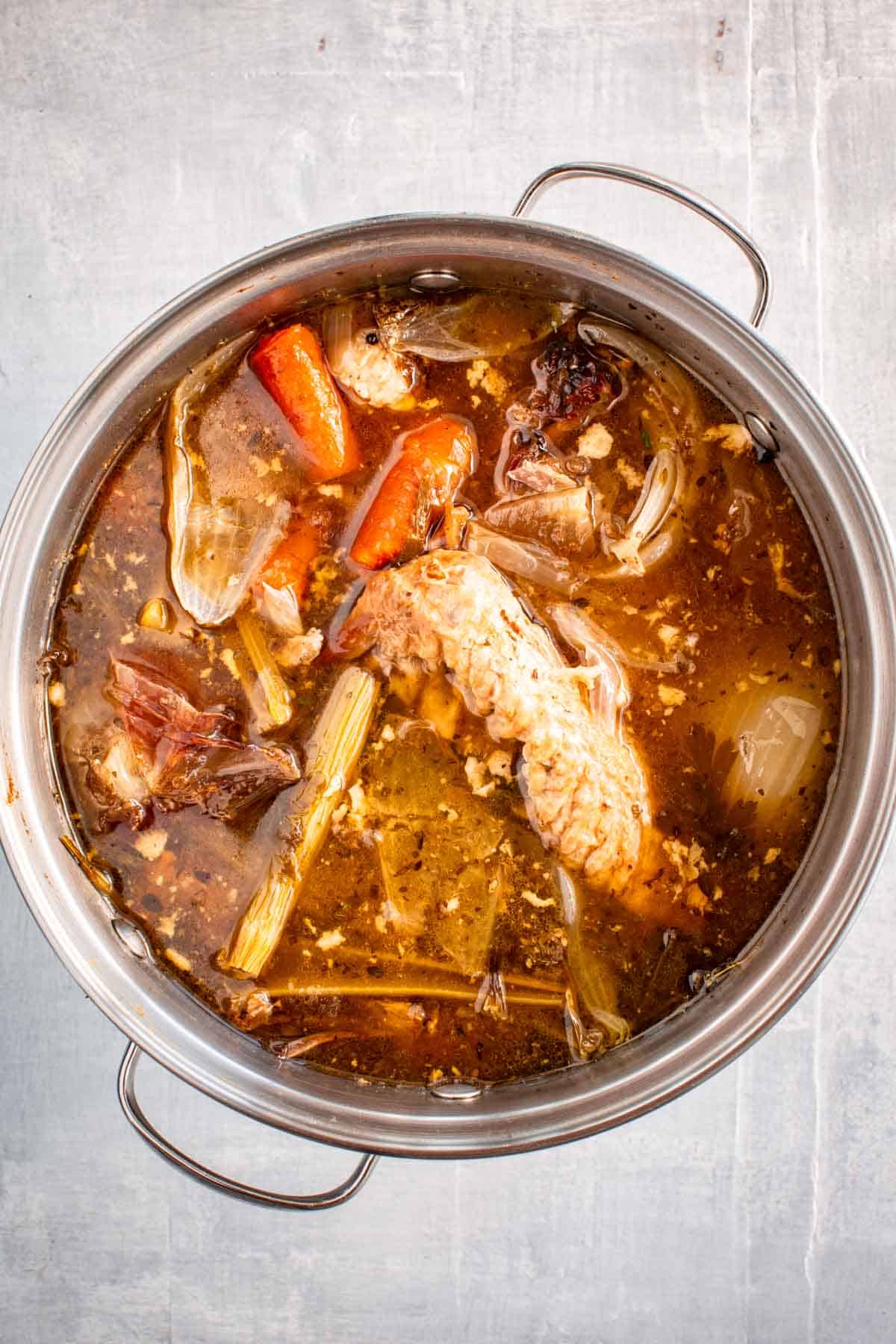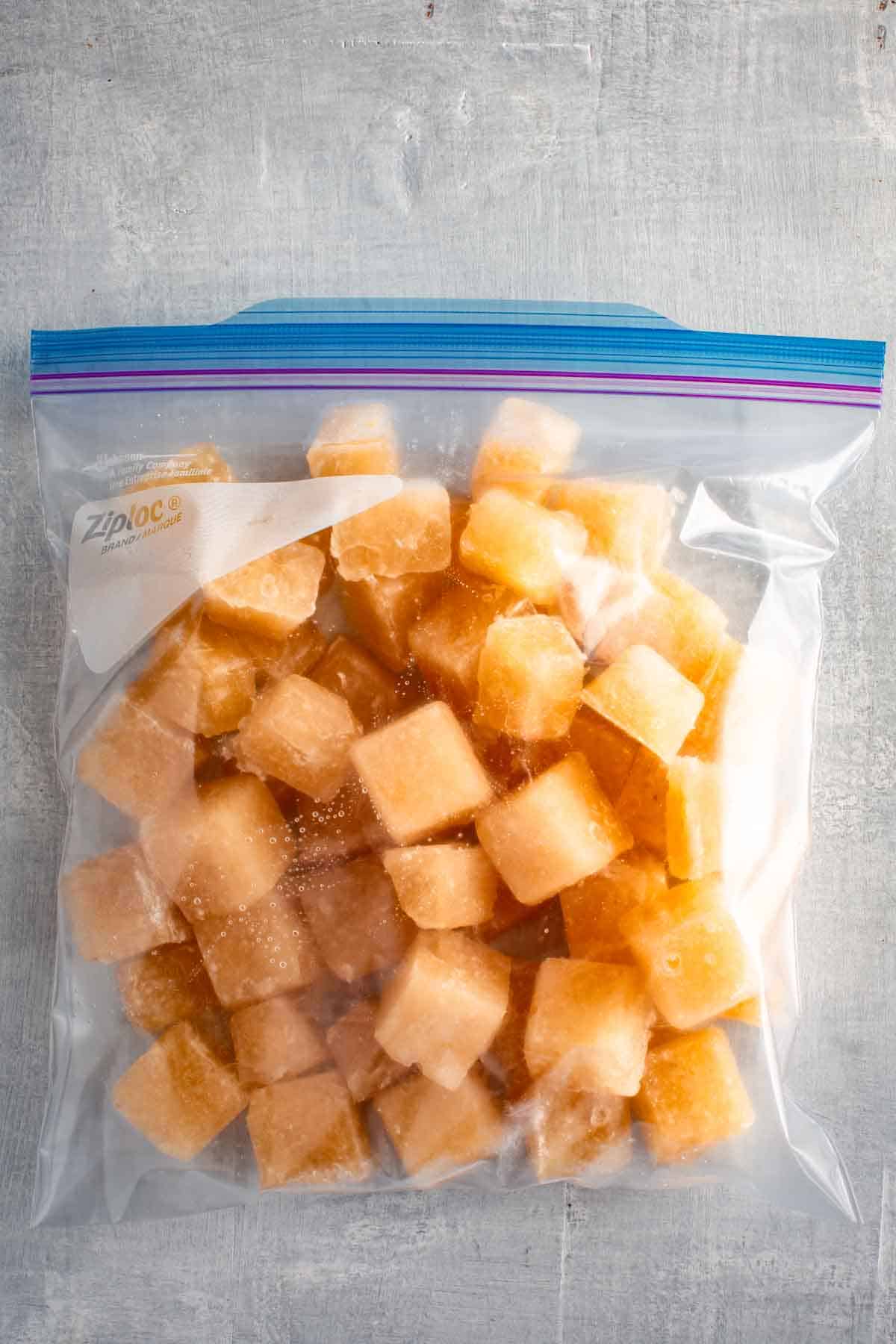Easy Homemade Thanksgiving Turkey Stock
This incredibly easy homemade turkey stock recipe is made using the leftover turkey carcass from Thanksgiving or another holiday dinner. It's rich and full bodied, thanks to all those bones, making it the ideal base for soups, sauces, gravy and more!
This post may contain affiliate links.

Hi, it's me, Coley, the girl who always volunteers to take home the turkey carcass from Thanksgiving dinner. You should be that person too!
What some might consider trash, others recognize as an absolute culinary treasure. A leftover roast turkey, once picked of all its meat, still has a ton of flavor left to offer. Don't let it go to waste!
Related: Learn the Easy Way to Carve a Turkey.
Simmered slowly with a few other aromatics transforms a simple, often discarded ingredient, into a rich, nutrient-dense, flavorful homemade stock that can be used in a multitude of different ways.
Use up the last remnants of your Thanksgiving dinner to make this rich, aromatic homemade turkey stock to enhance your soups, stews, sauces, chili and more!
Minimize food waste while also stocking your freezer with a staple ingredient you can use for months to come. It's win win!
Why this recipe works
- Transforms Thanksgiving leftovers, scraps and other basic pantry ingredients into liquid gold.
- Turkey bones add tons of body thanks to their natural gelatin and collagen.
- Starting with cold water allows the flavors to gradually infuse into the liquid.
- Simmered for hours to ensure a rich, robust, aromatic stock.
- Easily adaptable to what you have on hand - make it as complex or simply flavored as you like!

Ingredient Notes
- Leftover Turkey Carcass - While you can always make a stock with fresh turkey or chicken, using the carcass from an already roasted and carved bird is a great way to use up every last bit of turkey and minimize waste. The leftover bones, meat and connective tissue from the whole turkey carcass add incredible body, depth and so much flavor, making a really great turkey stock. You can also add the turkey neck or some turkey wings to give the broth extra flavor.
- Fresh Vegetables - Carrots, celery and onion (mirepoix or Italian sofrito) are all you need to make a delicious stock. But it's also a great way to use up any vegetables you have laying around. I like to keep a stash of vegetable scraps in my freezer to add to stocks whenever I make them. Feel free to add extra carrots, celery stalks, bay leaves or whatever you want to increase the flavor of the stock. Root vegetables like turnips, rutabaga, parsnips, celeriac all add really nice flavor to homemade turkey stock. No need to peel or chop your veggies - just give them a good scrub and cut them into large chunks.
- Aromatics - Optional, but I recommend adding some additional flavorings like garlic cloves, fresh thyme, fresh parsley, bay leaf and whole peppercorns. I prefer using fresh herbs, but a few pinches of dried herbs will work too. You can make this basic stock recipe without any additional aromatics, but they help create an even more flavorful stock.
*Full ingredient list with quantities is in the recipe card at the bottom of this post.
Helpful Equipment
- Large Stockpot - Any large pot or Dutch oven will work for making homemade turkey stock. It just needs to be large enough to fit all of the ingredients and enough water to cover them.
- Slow Cooker - A crockpot is a great method for making stock because it keeps the liquid at a very low, consistent temperature for a long amount of time, which is exactly what you want to extract the best flavor from the ingredients.
- Strainer - A fine-mesh strainer is best so that it catches all of the solids, but you can make a colander work too. Line it with cheesecloth to achieve an extra clear liquid.
- Slotted Spoon - I like to use this to scoop out and discard some of the larger ingredients before straining the whole pot to make it a little bit easier.
- Ladle - This is helpful for skimming fat and impurities off of the surface, and is also helpful when transferring the stock to containers for storage.
- Storage Containers - If not using your stock right away, you'll need some airtight containers to store it for later. I use a few different sized containers or mason jars because I often freeze my stock and want the options for how much stock to defrost. Make sure to use freezer-safe containers if planning to freeze.
- Ice Cube Trays - This is optional, but highly recommended. Freeze your stock in ice cube trays, then store the cubes in a zip-top bag. Sometimes a recipe will call for just a little bit of stock, so these are great to use when you only need a small amount.
- Zip-top Bags - Some people like to freeze stocks and soups in zip-top bags so they can freeze flat and then stack for easier storage. You will also need some zip-top bags to store your turkey stock ice cubes.
Step by step instructions
Pick any remaining leftover turkey meat off of the turkey carcasses, then add it to a large stock pot. You may need to break it into smaller pieces in order to fit.
Place the vegetables and aromatics all around the turkey bones wherever they will fit. Cover with cold water and place on the stove.


Bring up to a boil, then reduce to a simmer on the lowest setting on your stove. Cover and cook for a minimum of 6 hours and up to 24. Occasionally check on your stock and skim any fat or impurities from the top if you wish.
Turn off the heat and allow the stock to cool slightly. Use a slotted spoon to remove some of the larger ingredients and discard.
Place a fine mesh strainer over top of another stock pot or large bowl, then pour in the stock. Discard the solids and strain again if necessary.
Transfer the stock to storage containers and use as desired.

Tips for success
- Start with cold water to allow the flavors to slowly infuse into the liquid as it gradually heats.
- Don't use too much water. This will ultimately depend on the size of your turkey carcass and volume of other ingredients, but it's important that all of your ingredients are covered with water but not swimming in it, otherwise your stock will be diluted and weak.
- Maintain a very gentle simmer by keeping your pot or slow cooker on the lowest setting possible.
- For a very clean and clear stock, occasionally skim the top of all foam, fat and impurities while it cooks, then strain it through a fine mesh sieve lined with cheesecloth.
- Salt sparingly. I do not salt my stock at all, but you can if you prefer. It's best to under-season since you can always add more later.
- To remove excess fat from your stock, let it chill overnight in the refrigerator. The solidified fat rises to the top and will then harden so it can be easily removed and discarded or saved for another use.
- To make homemade turkey bone broth, allow the stock to simmer for as long as possible, 18-24 hours is ideal. The best stock will always be solid and gelatinous when cold because of all the gelatin extracted from those leftover Thanksgiving turkey bones.
Serving Suggestions
This delicious homemade turkey stock tastes lightyears better than anything store-bought. It will take homemade soups and sauces to the next level thanks to all the rich, slowly infused flavor that even the most flavorful broth from the grocery store can't achieve.
I often try to make a homemade turkey soup the next day after a big turkey dinner, which always starts with turkey stock. I add the leftover meat, assorted vegetables and sometimes small pasta like acini de pepe.
The great thing about homemade turkey stock is that you can use it anywhere that calls for chicken stock. You can make all kinds of soups, like Italian Wedding Soup, Ribollita, Chicken, Kale and White Bean Soup with Pesto, Chicken Tortilla Soup or Chicken Poblano Chili.
This homemade turkey stock adds luxurious body to mushroom risotto or this spring vegetable risotto.
It's also perfect for adding to sauces like homemade turkey gravy, enchiladas verdes, chicken cacciatore or in a pot pie. Homemade stock makes the filling in chicken pot pie, skillet turkey pot pie, or these individual turkey and butternut squash pot pies taste so much better than store bought broth.
If you simmered your stock long enough (more than just a couple of hours), you have essentially made a delicious turkey bone broth, which touts many health benefits from collagen, gelatin and other nutrients. My favorite way to enjoy bone broth is by sipping it steaming hot in a mug, seasoned with lots of salt and pepper. Don't knock it till you try it!
You can also make chicken broth or stock the exact same way using a roasted chicken carcass instead!
How to Freeze
I like to freeze my homemade broth in several different sizes so that I always have options to use it in different applications.
- Transfer your flavorful turkey stock to mason jars or other airtight containers in varying sizes, then cover and freeze. Always let your stock cool down to room temperature before freezing. Never freeze hot liquids.
- Since liquid expands when it freezes, don't fill your containers all the way up to the top. They need breathing room - especially glass jars which could shatter.


I also love making turkey stock ice cubes. They're ideal for times when you only need a little bit of stock.
- Pour your broth into ice cube trays and freeze. Once froze, transfer them to a zip-top bag or airtight container and keep in the freezer until needed.
Stock can last in the freezer for up to 6 months, or longer if properly stored. I find the freshness starts to decline around the 6 month mark, but it's safe to use up to a year later.
To use, defrost first overnight in the refrigerator, in the microwave or on the stove top.
You can also add frozen stock directly to recipes and it will slowly melt into the food as it cooks.
FAQ
Yes, absolutely! I find that turkey stock can be even more flavorful than chicken stock, so adjust accordingly. You may need to dilute it with a bit of water so it's not overpowering.
Stock can keep in the refrigerator for up to 5 days. For longer storage, freeze for up to 6 months. If stored properly, your stock can last longer, but it will start to lose freshness around 6 months.
Stock is always made with bones and sometimes meat, and is simmered for a long time to really extract lots of flavor. Broth is typically made with mostly meat, and sometimes bones, but is not simmered for as long as stock so it has a lighter body and overall flavor. Bone broth is like stock, always made with bones, and is simmered for a very long time, often 18-24 hours, which fully extracts all of the gelatin and nutrients from the bones.
Technically you can overcook anything if you let it go long enough, but turkey stock benefits from being cooked longer. That said, more than 24 hours is excessive and could impart a bitter or unpleasant flavor.
Yes! Adding the giblets to your stock pot can add more flavor if you choose, however do not add the liver, as it will give a gamey, minerally and bitter flavor to the stock.
The cloudiness comes from impurities essentially becoming emulsified in the liquid, which can happen if you don't start with cold water or if the stock is cooked at too high heat. I don't mind a cloudy stock as long as it tastes good, but if it bothers you, try to skim the impurities off the top every so often while cooking, and motion the heat so that it never comes to a rolling boil.
Did you LOVE this recipe? Please leave a star ⭐️ rating and comment to let other readers know! I absolutely love hearing from you and do my best to answer all questions and comments. I love seeing your creations so please tag me on Instagram @ColeyCooks!
Want to Save This Recipe?
Enter your email & I'll send it to your inbox.
By submitting this form, you consent to receive emails from Coley Cooks.
Homemade Turkey Stock
Ingredients
- 1 turkey carcass any stuffing removed
- 1 large onion unpeeled, quartered
- 3 celery stalks halved or quartered if large
- 2 medium carrots unpeeled but scrubbed, halved
- 3-4 sprigs fresh parsley
- 3-4 sprigs fresh thyme
- 2 bay leaves
- 2 teaspoons whole peppercorns
- Cold water to cover
Instructions
- Begin by removing any remaining turkey meat from the turkey carcass and place it to a largestock pot. You might need to break it into smaller pieces for it to fit.
- Add the vegetables and aromatics around the turkey bones, wherever there's room. Cover everything with cold water and place the pot on the stove.
- Bring up a boil, and then lower the heat to the lowest setting on your stove to maintain a simmer. Cover the pot and allow it to cook for a minimum of 6 hours, or up to 24 hours. Check on the stock occasionally, and if you prefer, skim off any fat or impurities from the surface.
- Turn off the heat and let the stock cool slightly. Use a slotted spoon to remove the larger ingredients and discard them.
- Position a fine mesh strainer over another stock pot or a large bowl, then gently pour the stock through it. Dispose of the solids, and strain the liquid again if needed.
- Transfer the stock to storage containers and use it however needed.
Notes
- Start with cold water to allow the flavors to slowly infuse into the liquid as it gradually heats.
- Don't use too much water. This will ultimately depend on the size of your turkey carcass and volume of other ingredients, but it's important that all of your ingredients are covered with water but not swimming in it, otherwise your stock will be diluted and weak.
- Maintain a very gentle simmer by keeping your pot or slow cooker on the lowest setting possible.
- For a very clean and clear stock, occasionally skim the top of all foam, fat and impurities while it cooks, then strain it through a fine mesh sieve lined with cheesecloth.
- Salt sparingly. I do not salt my stock at all, but you can if you prefer. It's best to under-season since you can always add more later.
- To remove excess fat from your stock, let it chill overnight in the refrigerator. The solidified fat rises to the top and will then harden so it can be easily removed and discarded or saved for another use.
- To make homemade turkey bone broth, allow the stock to simmer for as long as possible, 18-24 hours is ideal. The best stock will always be solid and gelatinous when cold because of all the gelatin extracted from those leftover Thanksgiving turkey bones.





